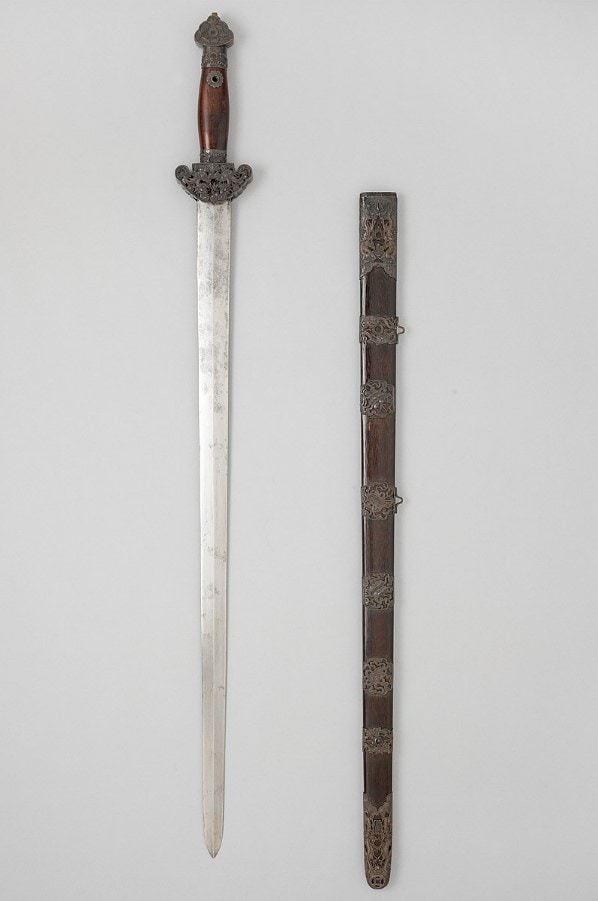What are the 2 Types of Chinese Swords?
Understanding the two primary types of Chinese swords, the jian and the dao, is crucial for anyone seeking to appreciate the rich history and cultural significance of Chinese weaponry. For millennia, these blades have transcended their practical purpose as instruments of war, becoming symbols of social status, artistic expression, and the evolution of Chinese martial arts traditions.
Comparing the Jian and Dao Swords
| Jian Sword | Dao Sword | |
| Construction | Double-edged straight sword | Single-edged sword for slashing and chopping |
| Origin: 7th century BCE | Origin: Shang Dynasty (evolved over time) | |
| One-handed: 45 to 80 cm, 700-900g | Moderately curved blades with single edge | |
| Guard shapes vary, pommel for balance | Hilts may be canted, guards disc-shaped | |
| Blade divided into three sections | Handles wrapped with cord, some have piercings | |
| Traditional construction: sanmei or wumei | Guards designed to protect user’s knuckles | |
| Materials: Bronze to steel | ||
| Usage | Versatile cut and thrust weapon | Primarily for slashing and chopping |
| Emphasis on stabbing, precise cuts, slashes | Adopted by cavalry during Han for sturdiness | |
| Historical test cutting (shizhan) on targets | Evolved into distinct types (yanmaodao, etc) | |
| Tai chi and martial arts practice | Various modifications influenced by Mongol sabers | |
| Notable forms: Sancai Jian, Kunwu Jian, etc. | Used by infantry, cavalry, adapted into polearms | |
| Continued adaptations in Yuan, Ming, Qing | ||
| Used in various combat scenarios |
What is a Jian Sword
The jian, a double-edged straight sword, has played a significant role in Chinese history for over 2,500 years. Originating in the 7th century BCE during the Spring and Autumn period, it is exemplified by artifacts such as the Sword of Goujian. Known as “The Gentleman of Weapons” in Chinese folklore, the jian is one of the four major weapons alongside the staff, spear, and sabre.
Construction
One-handed versions typically range from 45 to 80 centimeters in blade length, with an average weight of 700 to 900 grams. Guard shapes vary, with hilt designs accommodating either one or both hands. The hilt’s pommel provides balance and can be used strategically in combat.
The jian’s blade, divided into three sections—jiànfeng, zhongren, and jiàngen—supports various offensive and defensive techniques. Blades typically exhibit subtle profile taper and distal taper, with differential sharpening towards the tip. Traditional construction involves sanmei (three plate) or wumei (five plate) methods, with materials ranging from bronze to steel.
Usage
While variations exist in length, balance, and weight across different periods, the jian remains a versatile cut and thrust weapon, excelling in stabbing, precise cuts, and slashes rather than specializing in one form. Terracotta warriors in Qin Shi Huang’s tomb wielded jian made from copper, tin, and elements like nickel and cobalt.
Historical users engaged in test cutting, known as shizhan, on targets like caoren (grass men) made from bamboo or rice straw. Today, tai chi and other martial arts practitioners continue extensive jian training, considering expertise in its techniques the pinnacle of their kung fu. Notable jian forms include Sancai Jian, Kunwu Jian, Wudang Xuanmen Jian, and taijijian.
Where to Find a Jian Sword for Sale
If you’re looking to purchase a jian sword, there are several options to explore. Many online retailers specialize in martial arts equipment and offer a variety of jian swords, ranging from decorative pieces to functional blades for practice or cutting.
Folded Steel Han Jian Sword
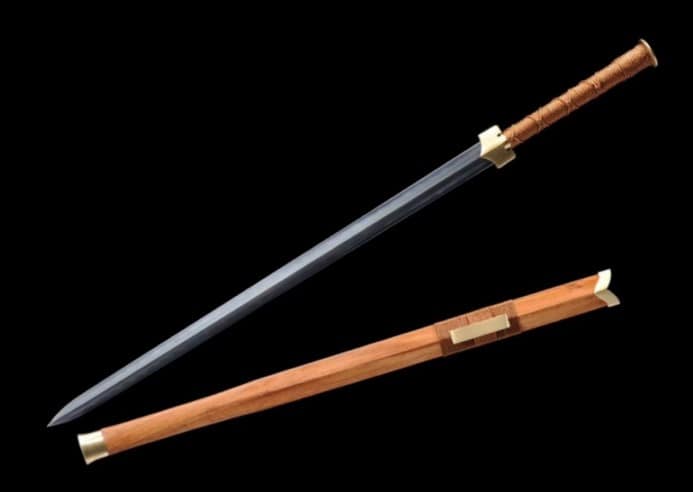
Features:
- Folded Steel Blade: The Chinese Han Jian sword features a hand-forged blade made of folded steel, with an impressive 8192 layers created through 13 foldings, and it is clay tempered with water quenching, resulting in a beautiful grain pattern (HADA) and a genuine hamon on the double edge.
- Hualee Wood Scabbard: The sword comes with a scabbard made of high-quality Hualee wood, adorned with detailed, cast brass ornamentation. The scabbard is wrapped with brown cord, adding to its elegance.
- Handcrafted Excellence: This sword is fully hand forged, hand polished, and hand sharpened, with a hard wood core handle wrapped in brown cord and high-quality brass fittings. Its meticulous craftsmanship enhances its collection value and makes it suitable for home decor, Chinese Kung Fu practice, and gifting.
Shi Huang Jian Sword
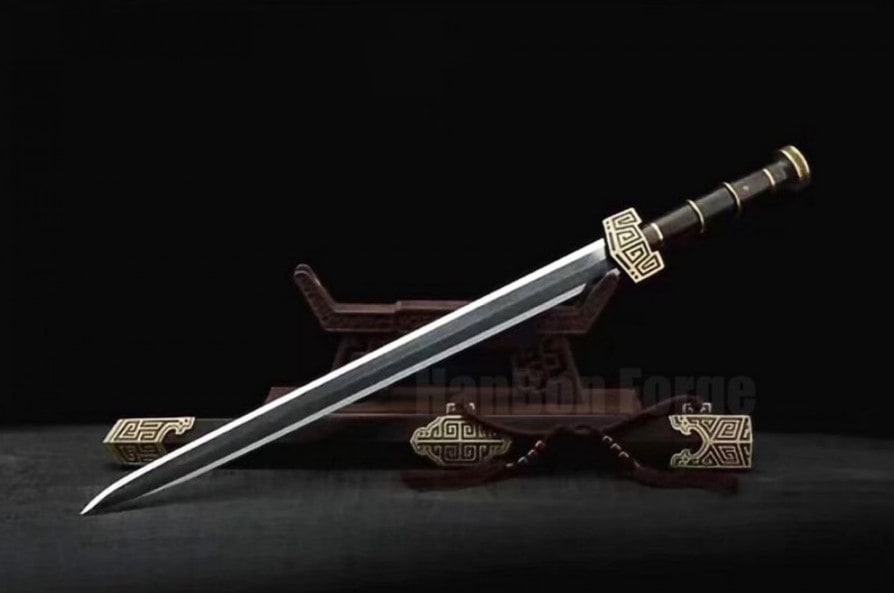
Features:
- Damascus Folded Steel Blade: The Shi Huang Jian Chinese Sword features a blade constructed from differentially hardened forge folded 1060 carbon steel, comprising 8,192 layers, showcasing an authentic folded pattern (hada) with hand polishing.
- Exquisite Craftsmanship: This Jian sword is meticulously crafted with pure brass fittings adorned with Qin dynasty patterns and a black ebony wood scabbard and handle, highlighting its attention to detail and historical aesthetics.
- Versatile Design: The sword is designed for both functionality and aesthetics, as it can be fully disassembled and assembled, and it comes with a free sword bag and certificate of authenticity.
Chinese God Dragon Jian Sword
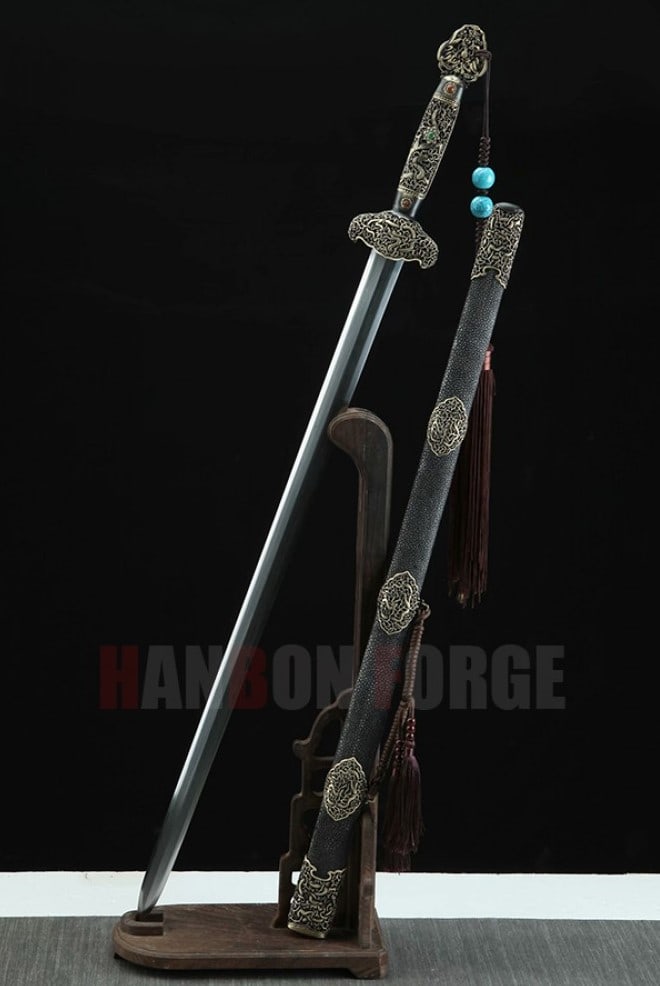
Features:
- Blade Material: Folded 14 times using clay tempered pattern steel for increased flexibility and 8192 layers, with a genuine Hamon and beautiful Hada pattern.
- Exquisite Design: Features brass fittings, a real rayskin-wrapped scabbard, and a handle inlaid with real jade decoration.
- Versatile Use: Suitable for collection, home furnishings, Chinese Kung Fu practice, and makes a great gift, accompanied by a free sword bag.
Longwang Jian Sword
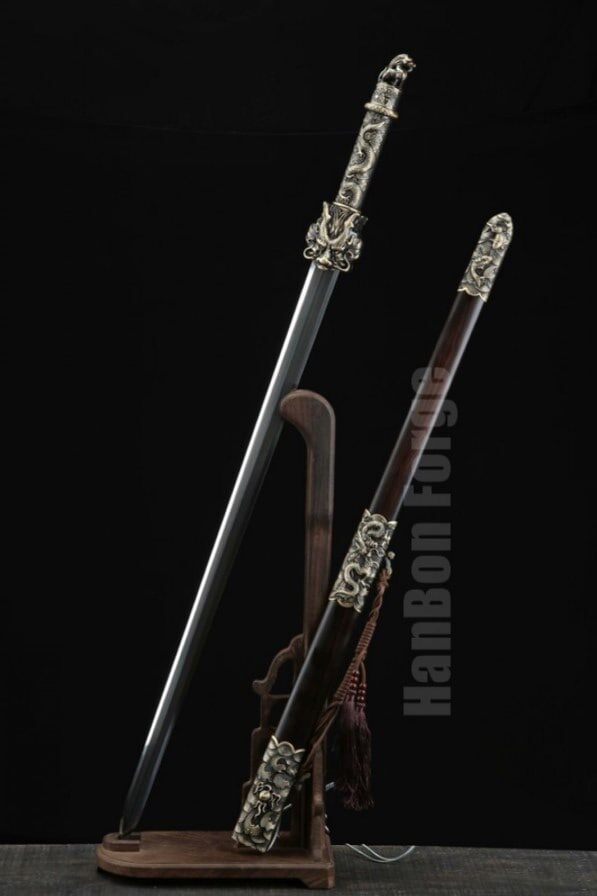
Features:
- Hand-Forged Excellence: The Longwang Jian Sword is crafted using traditional Chinese methods, with a folded pattern steel blade that undergoes clay tempering, resulting in a genuine hamon and beautiful Hada (folded pattern) on the blade.
- Exquisite Dragon Design: The sword features intricate dragon designs on both the scabbard and handle, symbolizing power, status, and good luck in ancient Chinese culture.
- High-Quality Materials: It is constructed with top-quality ebony for the scabbard and handle, complemented by exquisite brass fittings, making it a visually stunning and durable piece.
Damascus Han Jian Sword

Features:
- Damascus Folded Carbon Steel Blade: Crafted from folded carbon steel and clay tempered, this Han Jian sword features a beautiful grain pattern (HADA) and genuine hamon, ensuring both strength and durability.
- Traditional Design: The sword showcases a straight, double-edged blade with a hardwood handle wrapped in black and red silk cord in the traditional “X” pattern, along with high-quality brass tsuba (guard) and mountings.
- Exquisite Craftsmanship: With an overall length of 108 cm, a nagasa length of 76 cm, and a blade width of approximately 3.6 cm, this Han Jian sword is a meticulously crafted piece suitable for collection, home furnishings, Chinese Kung Fu practice, and gifting to friends.
Dragon Jian Sword
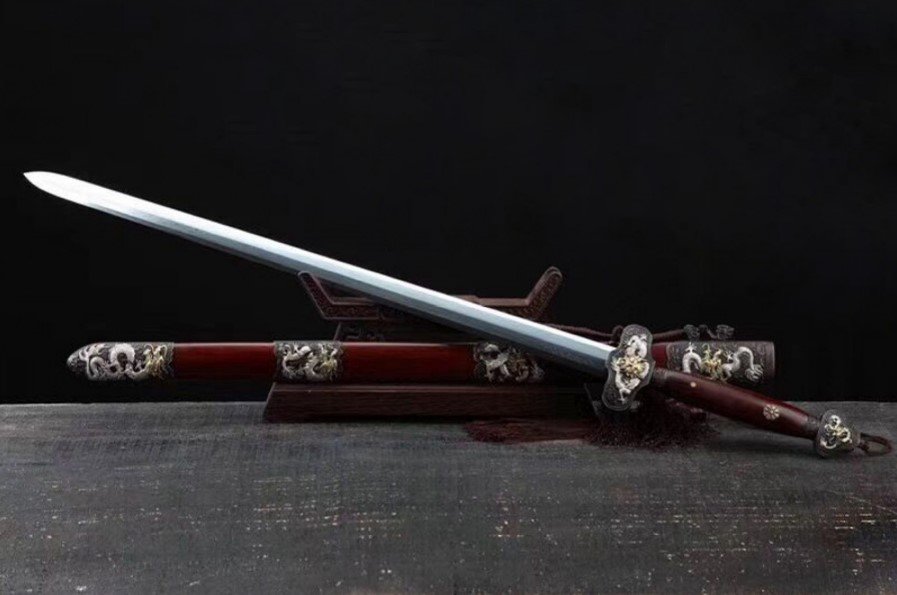
Features:
- Eight-Sided Damascus Blade: The Dragon Jian Sword boasts an eight-sided blade crafted from Damascus folded steel, meticulously folded 13 times to create an intricate 8192-layer grain pattern (HADA).
- Exquisite Rosewood Design: The sword features a top-quality rosewood scabbard and handle, complemented by brass mountings adorned with an ancient three-color dragon design, combining aesthetics with functionality.
- Impressive Dimensions: With an overall length of 120 cm, a razor-sharp 82 cm blade, and a weight of 2.23 kg (without scabbard), it is a formidable weapon suitable for advanced Tai Chi and Kung Fu practitioners, as well as those eager to test its cutting capabilities.
What is a Dao Sword
The dao is a single-edged Chinese sword designed primarily for slashing and chopping. It can have a straight or curved blade, and the more common variant is often referred to as the Chinese sabre. Those with wider blades are occasionally called Chinese broadswords.
In China, the dao holds a significant position as one of the four traditional weapons, grouped with the gun (stick or staff), qiang (spear), and the jian (double-edged sword) in what is known as “The General of Weapons.
Construction
While dao sword designs have varied throughout the centuries, single-handed dao from the Ming period onward, and their modern counterparts, share certain features. The blades are moderately curved and single-edged, often with a few inches of the back edge sharpened for versatility, enabling effective thrusts.
Hilts may be canted, curving opposite to the blade, enhancing handling for various cuts and thrusts. The handle is typically wrapped with cord, and hilts may have piercings for lanyards, though modern performance swords often feature tassels or scarves.
Guards are commonly disc-shaped and cupped, designed to prevent rainwater and blood from reaching the handle, ensuring a secure grip. In some cases, guards may have a thinner, s-curve design to protect the user’s knuckles.
Usage
The dao, originating in China’s Shang Dynasty, was initially straight-backed knives, evolving into single-edged weapons used for slashing and chopping. During the Han dynasty, its sturdiness, chopping efficiency, and ease of use made it popular among cavalry, leading to its gradual adoption by infantry and replacing the jian.
Throughout dynasties like Sui, Tang, Song, Yuan, Ming, and Qing, influenced by Mongol sabers, the dao underwent modifications, giving rise to distinct types like yanmaodao, liuyedao, piandao, and niuweidao. These variations catered to specific combat needs, allowing for thrusting attacks, draw-cutting, and slashing.
Even during the Qing period, variations like nandao and the “nine ringed broadsword” emerged, although these were likely designed more for demonstrations and performances than practical combat. The term dao also encompassed polearms like pudao and guandao, featuring a single-edged blade.
Where to Find a Dao Sword for Sale
Whether you’re a martial arts enthusiast, a collector, or simply fascinated by historical weapons, finding a dao sword can be an exciting journey. You can explore options ranging from online retailers specializing in replica or traditional swords to specialty martial arts stores.
Zhanma Dao Horse-Cutter Sword
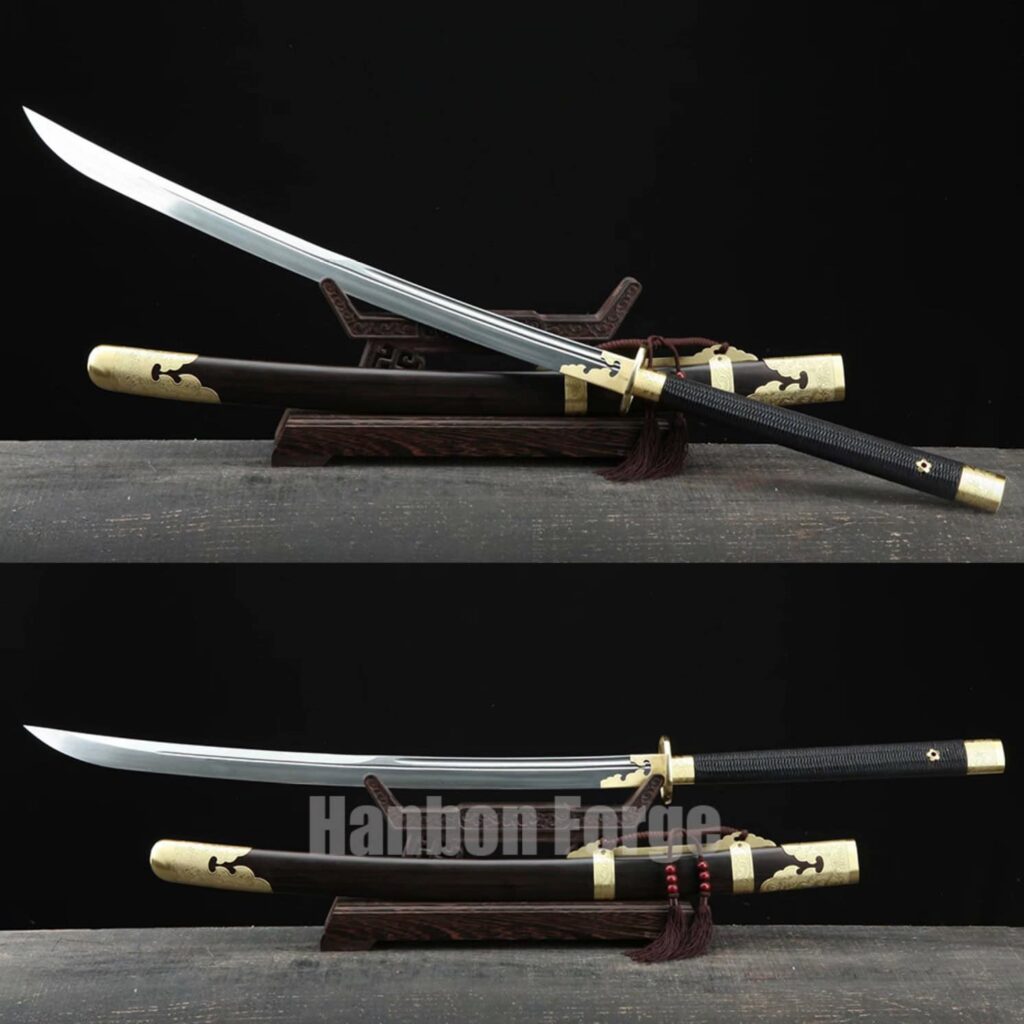
Features:
- Masterful Craftsmanship: This Chinese Zhanma Dao is hand-forged from folded pattern steel with visible grain layers, delivering a stunning and durable blade heat-treated for strength and hardness.
- Balanced and Functional Design: Featuring a thick full-tang blade with double bo-hi for excellent balance, it’s secured with bamboo pegs in a hardwood handle and complemented by an ebony scabbard with brass fittings.
- Versatile and Practical: Ideal for tai chi, kung fu, and wushu practice, as well as display, the sword is durable enough for tameshigiri and bamboo cutting, with the added bonus of optional signature engraving and a free sword bag.
Teng Long Dao Sword
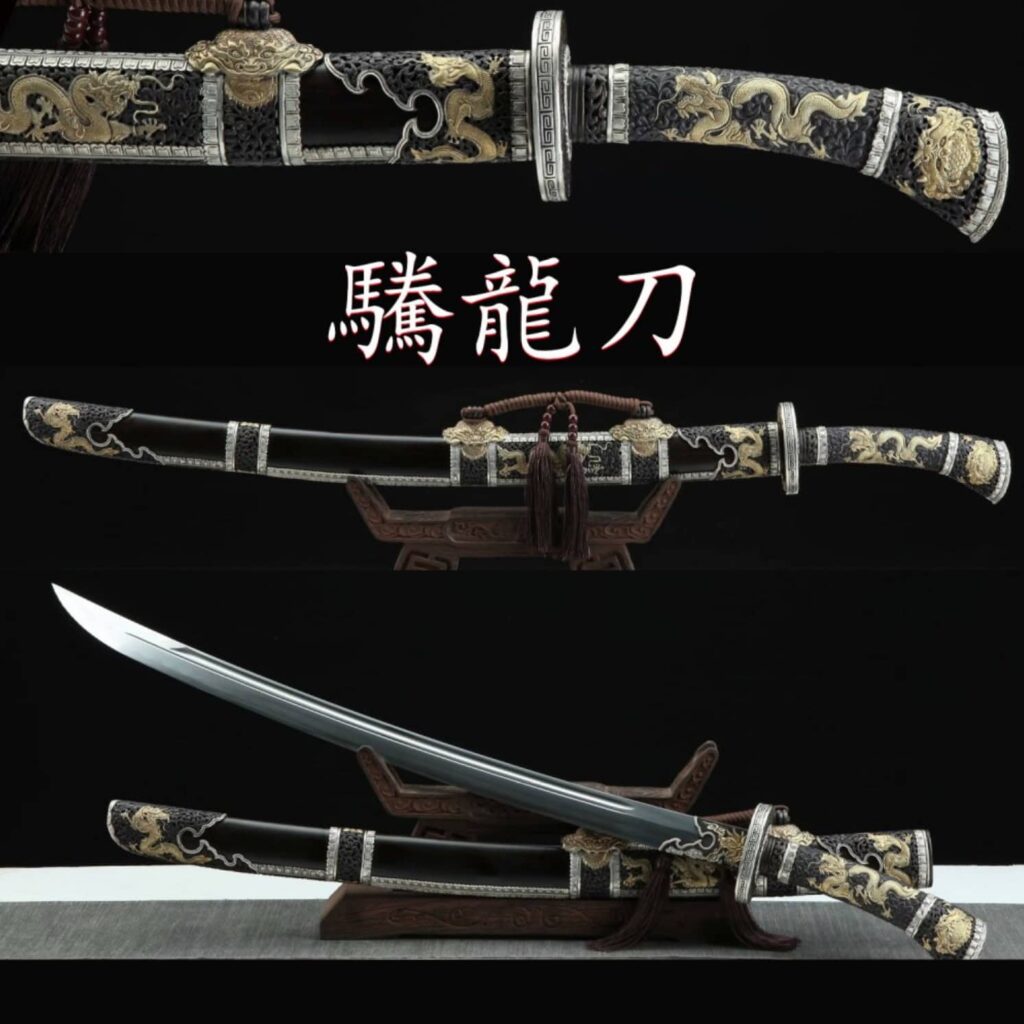
Features:
- Exquisite Blade Craftsmanship: The blade is made from folded pattern steel, clay tempered, and polished with hazuya, showcasing visible grain patterns for both strength and flexibility.
- Elegant Dragon Design: The brass fittings and tsuba feature a stunning dragon motif, complemented by a hardwood handle and an ebony wood scabbard with copper mountings.
- Customizable and Balanced: This full-tang sword includes double hi for optimal balance, and it can be customized with engravings to make it uniquely yours.
Heijing Dao War Saber

Features:
- Masterful Blade Design: The full-tang blade is crafted from Damascus folded steel with a stunning grain pattern (HADA) and visible layers, ensuring both beauty and exceptional cutting power.
- Exceptional Durability: Built to endure harsh conditions, this broadsword features a broad, heat-treated blade, a solid wood handle wrapped in black ito, and pure brass fittings for ultimate reliability.
- Elegant Accessories: The sword comes with a high-quality red wood scabbard for secure storage and a silk sword bag with a certificate of authenticity for added prestige.
Longwen Dragon Dao Sword
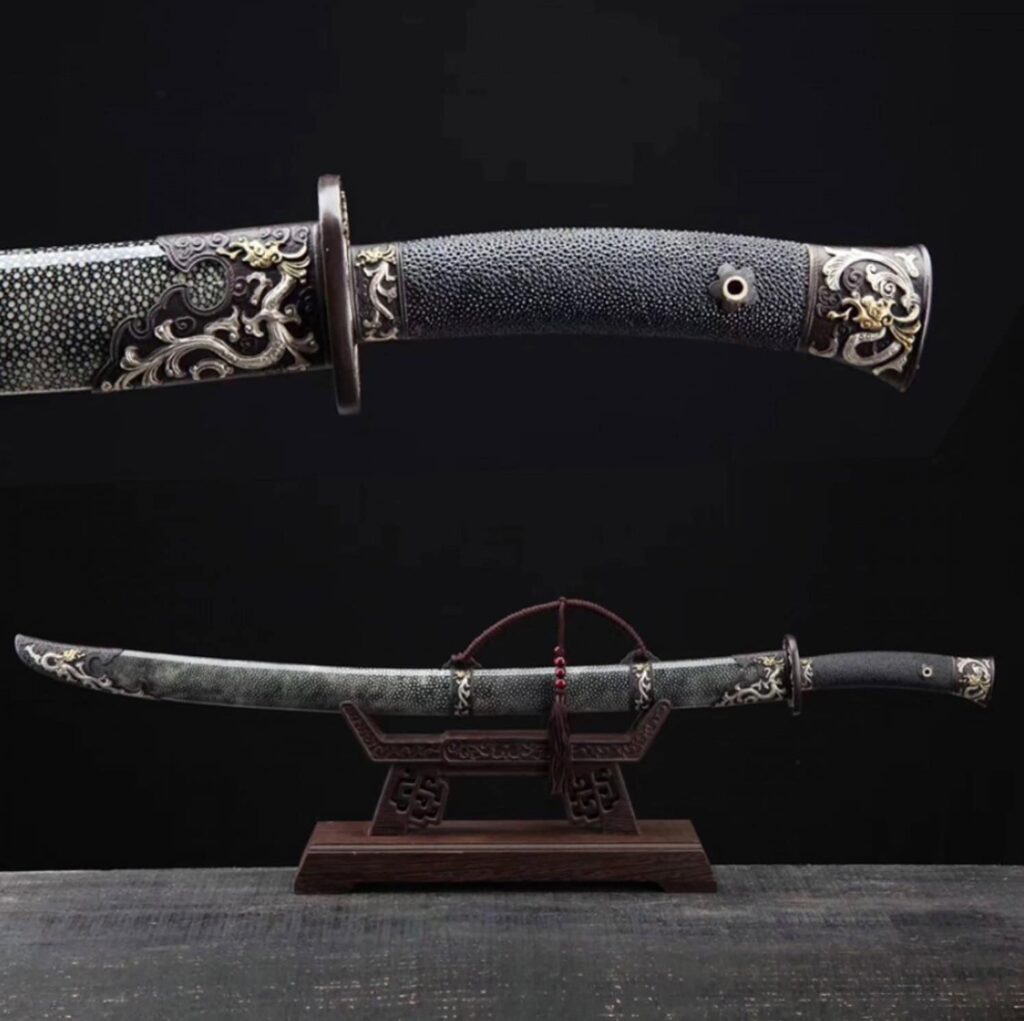
Features:
- Exquisite Blade Craftsmanship: The folded steel blade features 8192 grain layers (HADA) with a genuine hamon created through clay tempering, ensuring unmatched strength, flexibility, and durability.
- Premium Materials: The scabbard and handle are crafted from hardwood wrapped in black lacquered genuine ray skin, complemented by intricate pure brass dragon-themed fittings.
- Masterful Polishing: The blade is Hazuya-polished using ultra-fine Uchigumori stones, enhancing the hamon and achieving a mirror-like finish.
Tu Long Bao Dao Sword

Features:
- Authentic Construction: The Tu Long Bao Dao is crafted from 13-fold Damascus steel, showcasing a beautiful, visible grain pattern (HADA) and a hand-polished finish.
- Balanced and Functional Design: The sword features a Bo-Hi for better balance and an audible feedback when swung, enhancing its performance.
- Premium Details: The wooden handle is wrapped with brown cord, and the sword is paired with a top-quality ebony scabbard and finely carved copper mountings for added elegance.
Qilin Dao Sword
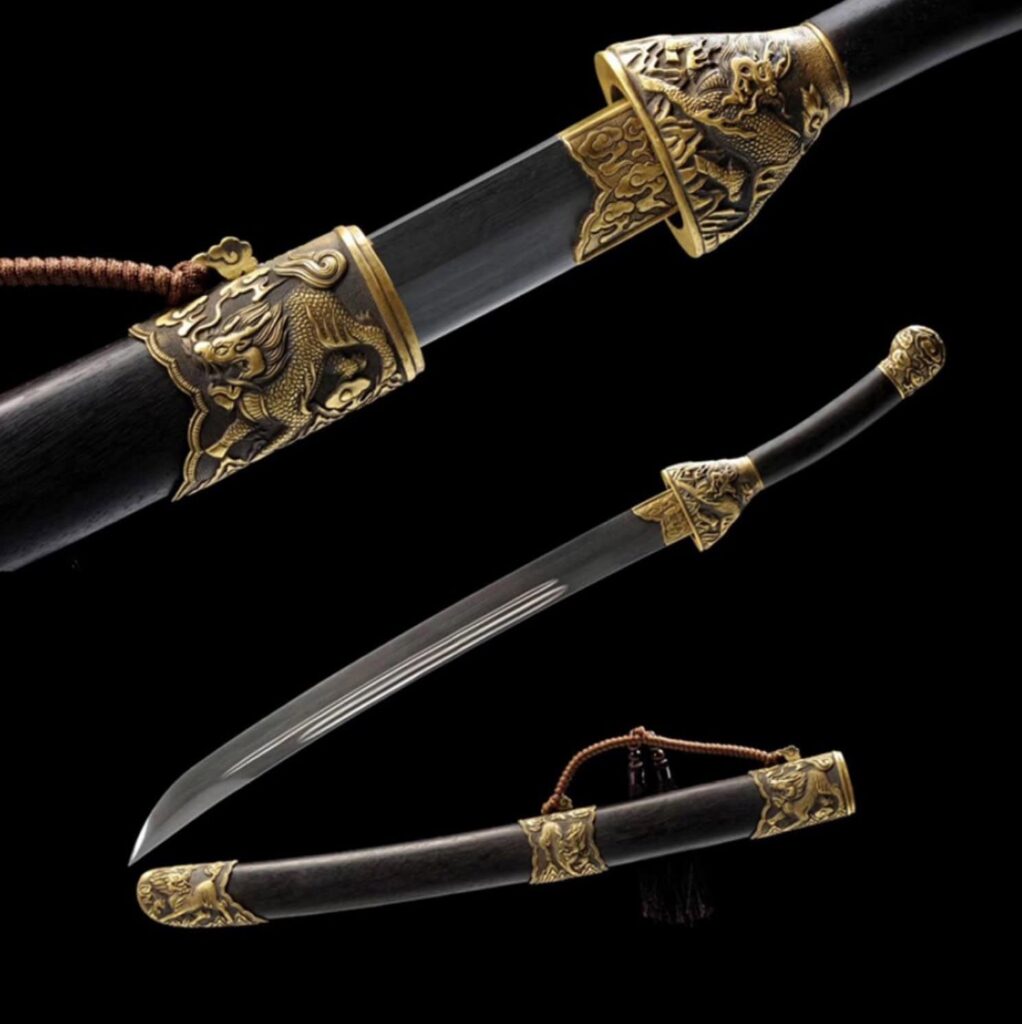
Features:
- Mythical Design: The Qilin Dao sword is inspired by the mythical Qilin, symbolizing kindness and harmony, and features intricate brass fittings with Qilin designs.
- Damascus Steel Blade: Crafted from Damascus folded steel with hand polishing, the blade showcases a stunning grain pattern and is treated for durability with a double bo-hi for added resonance.
- Premium Craftsmanship: The sword includes a black ebony wooden sheath and handle, complemented by pure brass fittings, and comes with a free sword bag and certificate of authenticity.
Conclusion
Between the jian and the dao, I find myself more inclined towards the jian. My interest in martial arts, particularly tai chi, has given me some experience with the jian. The sword’s balance and the smoothness of its movements fit well with the flowing forms of tai chi, making practice both calming and precise. The double-edged design of the jian allows for versatile use, including thrusts, cuts, and slashes, which feels intuitive and controlled.
The historical and cultural significance of the jian also appeals to me. It has long been associated with nobility and scholarly pursuit in Chinese culture. The craftsmanship involved in traditional jians, with techniques like sanmei or wumei, adds an artistic element that I find fascinating.
While the dao is known for its practicality and effectiveness in slashing and chopping, which made it popular among cavalry and infantry, it doesn’t resonate with me as much. The dao’s robust design and straightforward nature are impressive, especially considering its historical adaptations for various combat needs.
However, my preference leans towards the jian because its balance and precision align more closely with the style of martial arts I enjoy. The jian’s design and use in tai chi provide a harmonious and controlled experience that I appreciate.
Some links on this site are affiliate links, which means if you click and buy something, we get a tiny commission—like a virtual high-five in cash form (don’t worry, it costs you nothing).

